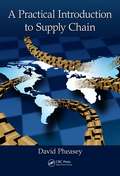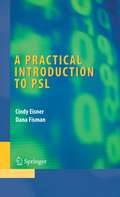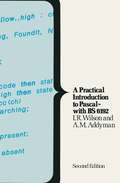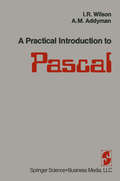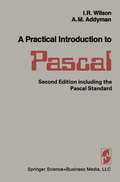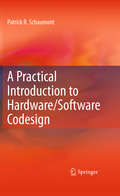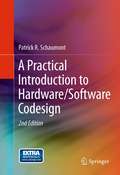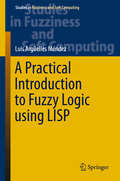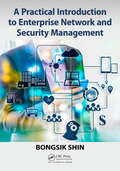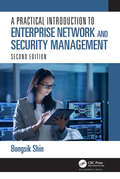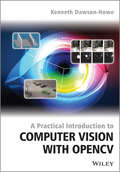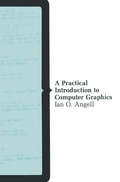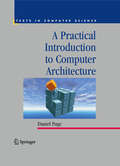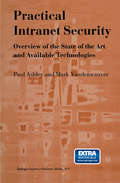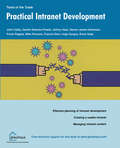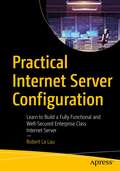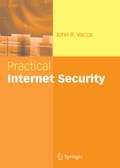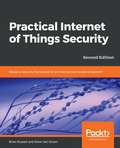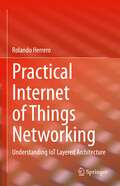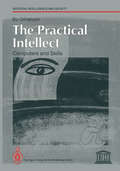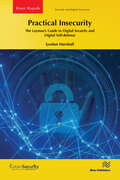- Table View
- List View
A Practical Introduction to Supply Chain
by David PheaseyIn many businesses, supply chain people are trapped in reactive roles where they source, contract, purchase, receive, warehouse, and ship as a service. However, in some businesses suppliers contribute to improvement programs, technology, funding, marketing, logistics, and engineering expertise. Breaking into a proactive supply chain role takes broad thinking, a talent for persuasion, and the courage to go after it. This book supplies proven methods to help you do so.A Practical Introduction to Supply Chain describes how to run an efficient supply chain that exceeds expectations in terms of cost, quality, and supplier delivery. It explains the need to integrate systems, the flow of information, and the way in which people work together between commercial purchasing, materials management, and distribution parts of the supply chain.Sharing powerful insights from the perspective of a supply chain manager, the book details practical techniques drawn from the author’s decades of experience. It presents methods that apply directly to supply chains involving a physical product, manufactured internally or outsourced, as well as physical operations such as oilfield services.This book demonstrates how to make a supply chain organization work in practice—contributing more to business success than traditional purchasing and logistics organizations can. In addition to writing about practical supply chain issues and approaches, the author also describes proven methods he used while working with client teams on assignments. He also details some of the ways his teams used to manage the people part of the change.
A Practical Introduction to Supply Chain
by David PheaseyIn many businesses, supply chain people are trapped in reactive roles where they source, contract, purchase, receive, warehouse, and ship as a service. However, in some businesses suppliers contribute to improvement programs, technology, funding, marketing, logistics, and engineering expertise. Breaking into a proactive supply chain role takes broad thinking, a talent for persuasion, and the courage to go after it. This book supplies proven methods to help you do so.A Practical Introduction to Supply Chain describes how to run an efficient supply chain that exceeds expectations in terms of cost, quality, and supplier delivery. It explains the need to integrate systems, the flow of information, and the way in which people work together between commercial purchasing, materials management, and distribution parts of the supply chain.Sharing powerful insights from the perspective of a supply chain manager, the book details practical techniques drawn from the author’s decades of experience. It presents methods that apply directly to supply chains involving a physical product, manufactured internally or outsourced, as well as physical operations such as oilfield services.This book demonstrates how to make a supply chain organization work in practice—contributing more to business success than traditional purchasing and logistics organizations can. In addition to writing about practical supply chain issues and approaches, the author also describes proven methods he used while working with client teams on assignments. He also details some of the ways his teams used to manage the people part of the change.
A Practical Introduction to PSL (Integrated Circuits and Systems)
by Cindy Eisner Dana FismanThis book describes the Property Specification Language PSL, recently standardized as IEEE Standard 1850-2005. PSL was developed to fulfill the following requirements: easy to learn, write, and read; concise syntax; rigorously well-defined formal semantics; expressive power, permitting the specification for a large class of real world design properties; known efficient underlying algorithms in simulation, as well as formal verification. Basic features are covered, as well as advanced topics such as the use of PSL in multiply-clocked designs. A full chapter is devoted to common errors, gathered through the authors' many years of experience in using and teaching the language.
A Practical Introduction to Pascal
by WILSON/ADDYMANThe popularity of Pascal as a teaching language has rapidly increased, as demonstrated by Addyman's survey conducted over a11 European and American institutions (Comput. Bull., Se ries 2,8, June 1976,31). This is due both to the desirable features of the language and to the ease of producing an efficient com piler. As an instance of the latter, the authors have investigated the full CDC CYBER compiler and found it to throughput at 1.8 times the rate of the manu facturer's Fortran compiler. These features of the language and compilers have also been favourably regarded by system programmers and users of rnicroprocessors. In the latter field, it is the belief of the authors that Pascal will supersede the programming language BASIC. Specifically, undergraduates in the Department of Computer Science at Manchester University program largely in Pascal. An introductory le~ture course on basic programming techniques, given at Manchester, has been taken as a basis for this book. In addition to lectures, the course consists of two kinds of practical session. The first is based on the solution of short pencil-and-paper exercises. The second requires the student to write complete programs and run them in an 'edit and go' mode on interactive computer terminals. Each chapter of the book conc1udes with exercises and problems suitable for these purposes. Although solutions to a11 of these are not presented in the book, teaching staff may obtain them by application to the authors.
A Practical Introduction to Pascal
by WILSON/ADDYMANSince the first edition of this book was written in 1977, there has been a tremendous increase in the use of Pascal. This increased use has had two significant effects. (1) It has produced a bett er understanding of the facilities of Pascal and their use. (2) It has fostered the production of the ISO standard for Pascal. This second edition reflects both this better understanding and the clarifications and changes to Pascal which have resulted from the production of the BSljlSO Pascal standard. The standard (BS 6192, which supplies the technical content for ISO 7185) is the definitive document on Pascal. My work on the Pascal standard has convinced me that the description of a programming language may be tutorial, or it may be definitive, or it may be neither! The chapters of this book do not constitute a definitive description of Pascal. They are essentially tutorial. The book is based on an introductory lecture course given at Manchester. In addition to lectures, the course consists of two kinds of practical work. The first is based on the solution of short pencil-and-paper exercises. The second requires the student to write complete programs and run them using interactive computer terminals. Each chapter of the book concludes with exercises and problems suitable forthese purposes. Although solutions to all of these are not presented in the book, teaching staff may obtain them by application to the authors.
A Practical Introduction to Hardware/Software Codesign
by Patrick R. SchaumontThis is a practical book for computer engineers who want to understand or implement hardware/software systems. It focuses on problems that require one to combine hardware design with software design – such problems can be solved with hardware/software codesign. When used properly, hardware/software co- sign works better than hardware design or software design alone: it can improve the overall performance of digital systems, and it can shorten their design time. Hardware/software codesign can help a designer to make trade-offs between the ?exibility and the performanceof a digital system. To achieve this, a designer needs to combine two radically different ways of design: the sequential way of dec- position in time, using software, with the parallel way of decomposition in space, using hardware. Intended Audience This book assumes that you have a basic understandingof hardware that you are - miliar with standard digital hardware componentssuch as registers, logic gates, and components such as multiplexers and arithmetic operators. The book also assumes that you know how to write a program in C. These topics are usually covered in an introductory course on computer engineering or in a combination of courses on digital design and software engineering.
A Practical Introduction to Hardware/Software Codesign
by Patrick R. SchaumontThis textbook serves as an introduction to the subject of embedded systems design, with emphasis on integration of custom hardware components with software. The key problem addressed in the book is the following: how can an embedded systems designer strike a balance between flexibility and efficiency? The book describes how combining hardware design with software design leads to a solution to this important computer engineering problem. The book covers four topics in hardware/software codesign: fundamentals, the design space of custom architectures, the hardware/software interface and application examples. The book comes with an associated design environment that helps the reader to perform experiments in hardware/software codesign. Each chapter also includes exercises and further reading suggestions. Improvements in this second edition include labs and examples using modern FPGA environments from Xilinx and Altera, which will make the material in this book applicable to a greater number of courses where these tools are already in use. More examples and exercises have been added throughout the book. “If I were teaching a course on this subject, I would use this as a resource and text. If I were a student who wanted to learn codesign, I would look for a course that at least used a similar approach. If I were an engineer or engineering manager who wanted to learn more about codesign from a very practical perspective, I would read this book first before any other. When I first started learning about codesign as a practitioner, a book like this would have been the perfect introduction.” --Grant Martin, Tensilica--
A Practical Introduction to Fuzzy Logic using LISP (Studies in Fuzziness and Soft Computing #327)
by Luis Argüelles MendezThis book makes use of the LISP programming language to provide readers with the necessary background to understand and use fuzzy logic to solve simple to medium-complexity real-world problems. It introduces the basics of LISP required to use a Fuzzy LISP programming toolbox, which was specifically implemented by the author to “teach” the theory behind fuzzy logic and at the same time equip readers to use their newly-acquired knowledge to build fuzzy models of increasing complexity. The book fills an important gap in the literature, providing readers with a practice-oriented reference guide to fuzzy logic that offers more complexity than popular books yet is more accessible than other mathematical treatises on the topic. As such, students in first-year university courses with a basic tertiary mathematical background and no previous experience with programming should be able to easily follow the content. The book is intended for students and professionals in the fields of computer science and engineering, as well as disciplines including astronomy, biology, medicine and earth sciences. Software developers may also benefit from this book, which is intended as both an introductory textbook and self-study reference guide to fuzzy logic and its applications. The complete set of functions that make up the Fuzzy LISP programming toolbox can be downloaded from a companion book’s website.
A Practical Introduction to Enterprise Network and Security Management
by Bongsik ShinComputer networking and cybersecurity are challenging subjects, partly because of the constant rise and fall of related technologies and IT paradigms. As the title implies, much focus of this book is on providing the audience with practical, as well as, theoretical knowledge necessary to build a solid ground for a successful professional career. A Practical Introduction to Enterprise Network and Security Management contains 12 chapters of the correct amount of coverage for a semester or quarter. It balances introductory and fairly advanced subjects on computer networking and cybersecurity to deliver effectively technical and managerial knowledge. It explains sometimes challenging concepts in a manner that students can follow with careful reading. A Practical Introduction to Enterprise Network and Security Management is designed to offer impactful, hands-on learning experiences without relying on a computer lab. First, each chapter comes with practical exercise questions. In the class setting, they are good as individual or group assignments. Many of them are based on simulated or real cases, and take advantage of actual industry products and systems for a reader to better relate theories to practice. Second, there are a number of information-rich screen shots, figures, and tables in each chapter carefully constructed to solidify concepts and thus enhance visual learning. A Practical Introduction to Enterprise Network and Security Management Is written for students studying management information systems, accounting information systems, or computer science in a semester of 15 to 16 weeks, and exposed to the subject for the first time Takes advantage of many real cases and examples, and actual industry products and services (software, hardware, and configurations) so that students can better relate concepts and theories to practice Explains subjects in a systematic, but very practical manner that students can follow through Provides students with practical understanding of both computer networking and cybersecurity Contains highly practical exercise questions, which can be individual or group assignments within or without the class, included in each chapter to reinforce learning. In addition to the thorough technical details, managerial issues including, enterprise network planning, design, and management from the practitioner’s perspective are embedded throughout the text to assist balanced learning. Bearing in mind of the critical importance of security in today’s enterprise networks, the text discusses the implications of network design and management on enterprise security whenever appropriate. Lastly, to reinforce knowledge in security management further, two chapters introduce the fundamentals of cybersecurity in terms of threat types and defense techniques.
A Practical Introduction to Enterprise Network and Security Management
by Bongsik ShinComputer networking and cybersecurity are challenging subjects, partly because of the constant rise and fall of related technologies and IT paradigms. As the title implies, much focus of this book is on providing the audience with practical, as well as, theoretical knowledge necessary to build a solid ground for a successful professional career. A Practical Introduction to Enterprise Network and Security Management contains 12 chapters of the correct amount of coverage for a semester or quarter. It balances introductory and fairly advanced subjects on computer networking and cybersecurity to deliver effectively technical and managerial knowledge. It explains sometimes challenging concepts in a manner that students can follow with careful reading. A Practical Introduction to Enterprise Network and Security Management is designed to offer impactful, hands-on learning experiences without relying on a computer lab. First, each chapter comes with practical exercise questions. In the class setting, they are good as individual or group assignments. Many of them are based on simulated or real cases, and take advantage of actual industry products and systems for a reader to better relate theories to practice. Second, there are a number of information-rich screen shots, figures, and tables in each chapter carefully constructed to solidify concepts and thus enhance visual learning. A Practical Introduction to Enterprise Network and Security Management Is written for students studying management information systems, accounting information systems, or computer science in a semester of 15 to 16 weeks, and exposed to the subject for the first time Takes advantage of many real cases and examples, and actual industry products and services (software, hardware, and configurations) so that students can better relate concepts and theories to practice Explains subjects in a systematic, but very practical manner that students can follow through Provides students with practical understanding of both computer networking and cybersecurity Contains highly practical exercise questions, which can be individual or group assignments within or without the class, included in each chapter to reinforce learning. In addition to the thorough technical details, managerial issues including, enterprise network planning, design, and management from the practitioner’s perspective are embedded throughout the text to assist balanced learning. Bearing in mind of the critical importance of security in today’s enterprise networks, the text discusses the implications of network design and management on enterprise security whenever appropriate. Lastly, to reinforce knowledge in security management further, two chapters introduce the fundamentals of cybersecurity in terms of threat types and defense techniques.
A Practical Introduction to Enterprise Network and Security Management
by Bongsik ShinA Practical Introduction to Enterprise Network and Security Management, Second Edition, provides a balanced understanding of introductory and advanced subjects in both computer networking and cybersecurity. Although much of the focus is on technical concepts, managerial issues related to enterprise network and security planning and design are explained from a practitioner’s perspective. Because of the critical importance of cybersecurity in today’s enterprise networks, security-related issues are explained throughout the book, and four chapters are dedicated to fundamental knowledge. Challenging concepts are explained so readers can follow through with careful reading. This book is written for those who are self-studying or studying information systems or computer science in a classroom setting. If used for a course, it has enough material for a semester or a quarter. FEATURES Provides both theoretical and practical hands-on knowledge and learning experiences for computer networking and cybersecurity Offers a solid knowledge base for those preparing for certificate tests, such as CompTIA and CISSP Takes advantage of actual cases, examples, industry products, and services so students can relate concepts and theories to practice Explains subjects in a systematic and practical manner to facilitate understanding Includes practical exercise questions that can be individual or group assignments within or without a classroom Contains several information-rich screenshots, figures, and tables carefully constructed to solidify concepts and enhance visual learning The text is designed for students studying information systems or computer science for the first time. As a textbook, this book includes hands-on assignments based on the Packet Tracer program, an excellent network design and simulation tool from Cisco. Instructor materials also are provided, including PowerPoint slides, solutions for exercise questions, and additional chapter questions from which to build tests.
A Practical Introduction to Enterprise Network and Security Management
by Bongsik ShinA Practical Introduction to Enterprise Network and Security Management, Second Edition, provides a balanced understanding of introductory and advanced subjects in both computer networking and cybersecurity. Although much of the focus is on technical concepts, managerial issues related to enterprise network and security planning and design are explained from a practitioner’s perspective. Because of the critical importance of cybersecurity in today’s enterprise networks, security-related issues are explained throughout the book, and four chapters are dedicated to fundamental knowledge. Challenging concepts are explained so readers can follow through with careful reading. This book is written for those who are self-studying or studying information systems or computer science in a classroom setting. If used for a course, it has enough material for a semester or a quarter. FEATURES Provides both theoretical and practical hands-on knowledge and learning experiences for computer networking and cybersecurity Offers a solid knowledge base for those preparing for certificate tests, such as CompTIA and CISSP Takes advantage of actual cases, examples, industry products, and services so students can relate concepts and theories to practice Explains subjects in a systematic and practical manner to facilitate understanding Includes practical exercise questions that can be individual or group assignments within or without a classroom Contains several information-rich screenshots, figures, and tables carefully constructed to solidify concepts and enhance visual learning The text is designed for students studying information systems or computer science for the first time. As a textbook, this book includes hands-on assignments based on the Packet Tracer program, an excellent network design and simulation tool from Cisco. Instructor materials also are provided, including PowerPoint slides, solutions for exercise questions, and additional chapter questions from which to build tests.
A Practical Introduction to Computer Vision with OpenCV
by Kenneth Dawson-HoweExplains the theory behind basic computer vision and provides a bridge from the theory to practical implementation using the industry standard OpenCV libraries Computer Vision is a rapidly expanding area and it is becoming progressively easier for developers to make use of this field due to the ready availability of high quality libraries (such as OpenCV 2). This text is intended to facilitate the practical use of computer vision with the goal being to bridge the gap between the theory and the practical implementation of computer vision. The book will explain how to use the relevant OpenCV library routines and will be accompanied by a full working program including the code snippets from the text. This textbook is a heavily illustrated, practical introduction to an exciting field, the applications of which are becoming almost ubiquitous. We are now surrounded by cameras, for example cameras on computers & tablets/ cameras built into our mobile phones/ cameras in games consoles; cameras imaging difficult modalities (such as ultrasound, X-ray, MRI) in hospitals, and surveillance cameras. This book is concerned with helping the next generation of computer developers to make use of all these images in order to develop systems which are more intuitive and interact with us in more intelligent ways. Explains the theory behind basic computer vision and provides a bridge from the theory to practical implementation using the industry standard OpenCV libraries Offers an introduction to computer vision, with enough theory to make clear how the various algorithms work but with an emphasis on practical programming issues Provides enough material for a one semester course in computer vision at senior undergraduate and Masters levels Includes the basics of cameras and images and image processing to remove noise, before moving on to topics such as image histogramming; binary imaging; video processing to detect and model moving objects; geometric operations & camera models; edge detection; features detection; recognition in images Contains a large number of vision application problems to provide students with the opportunity to solve real problems. Images or videos for these problems are provided in the resources associated with this book which include an enhanced eBook
A Practical Introduction to Computer Vision with OpenCV
by Kenneth Dawson-HoweExplains the theory behind basic computer vision and provides a bridge from the theory to practical implementation using the industry standard OpenCV libraries Computer Vision is a rapidly expanding area and it is becoming progressively easier for developers to make use of this field due to the ready availability of high quality libraries (such as OpenCV 2). This text is intended to facilitate the practical use of computer vision with the goal being to bridge the gap between the theory and the practical implementation of computer vision. The book will explain how to use the relevant OpenCV library routines and will be accompanied by a full working program including the code snippets from the text. This textbook is a heavily illustrated, practical introduction to an exciting field, the applications of which are becoming almost ubiquitous. We are now surrounded by cameras, for example cameras on computers & tablets/ cameras built into our mobile phones/ cameras in games consoles; cameras imaging difficult modalities (such as ultrasound, X-ray, MRI) in hospitals, and surveillance cameras. This book is concerned with helping the next generation of computer developers to make use of all these images in order to develop systems which are more intuitive and interact with us in more intelligent ways. Explains the theory behind basic computer vision and provides a bridge from the theory to practical implementation using the industry standard OpenCV libraries Offers an introduction to computer vision, with enough theory to make clear how the various algorithms work but with an emphasis on practical programming issues Provides enough material for a one semester course in computer vision at senior undergraduate and Masters levels Includes the basics of cameras and images and image processing to remove noise, before moving on to topics such as image histogramming; binary imaging; video processing to detect and model moving objects; geometric operations & camera models; edge detection; features detection; recognition in images Contains a large number of vision application problems to provide students with the opportunity to solve real problems. Images or videos for these problems are provided in the resources associated with this book which include an enhanced eBook
A Practical Introduction to Computer Graphics (Computers And Their Applications Ser.)
by Ian O. AngellA Practical Introduction to Computer Architecture (Texts in Computer Science)
by Daniel PageIt is a great pleasure to write a preface to this book. In my view, the content is unique in that it blends traditional teaching approaches with the use of mathematics and a mainstream Hardware Design Language (HDL) as formalisms to describe key concepts. The book keeps the “machine” separate from the “application” by strictly following a bottom-up approach: it starts with transistors and logic gates and only introduces assembly language programs once their execution by a processor is clearly de ned. Using a HDL, Verilog in this case, rather than static circuit diagrams is a big deviation from traditional books on computer architecture. Static circuit diagrams cannot be explored in a hands-on way like the corresponding Verilog model can. In order to understand why I consider this shift so important, one must consider how computer architecture, a subject that has been studied for more than 50 years, has evolved. In the pioneering days computers were constructed by hand. An entire computer could (just about) be described by drawing a circuit diagram. Initially, such d- grams consisted mostly of analogue components before later moving toward d- ital logic gates. The advent of digital electronics led to more complex cells, such as half-adders, ip- ops, and decoders being recognised as useful building blocks.
Practical Intranet Security: Overview of the State of the Art and Available Technologies
by Paul M. Ashley M. VandenwauverForeword by Lars Knudsen Practical Intranet Security focuses on the various ways in which an intranet can be violated and gives a thorough review of the technologies that can be used by an organization to secure its intranet. This includes, for example, the new security architecture SESAME, which builds on the Kerberos authentication system, adding to it both public-key technology and a role-based access control service. Other technologies are also included such as a description of how to program with the GSS-API, and modern security technologies such as PGP, S/MIME, SSH, SSL IPSEC and CDSA. The book concludes with a comparison of the technologies. This book is different from other network security books in that its aim is to identify how to secure an organization's intranet. Previously books have concentrated on the Internet, often neglecting issues relating to securing intranets. However the potential risk to business and the ease by which intranets can be violated is often far greater than via the Internet. The aim is that network administrators and managers can get the information that they require to make informed choices on strategy and solutions for securing their own intranets. The book is an invaluable reference for network managers and network administrators whose responsibility it is to ensure the security of an organization's intranet. The book also contains background reading on networking, network security and cryptography which makes it an excellent research reference and undergraduate/postgraduate text book.
Practical Intranet Development
by John Colby Gareth Downes-Powell Jeffrey Haas Darren J. Harkness Frank Pappas Mike Parsons Francis Storr Inigo Surguy Ruud VoigtAn intranet can be a powerful tool. A well-designed intranet becomes the key resource and communications platform for your organization, used by members of staff as their first destination for information. In contrast, a poorly designed intranet will sit unused, accumulating useless information, and eating up IT budgets. So, how do you avoid this situation, and make sure you design the most useful, and usable, intranet? This book takes you through the steps you need to take to make an invaluable intranet, from identifying your users' needs and building an indispensable tool, to marketing the results. It guides you through the problems that may occur, passing on invaluable advice from people who have been through the process before. We start by setting the scene, giving an overview of what intranets are and how to justify it to your organization. We then give you a rundown of the main areas you'll need to think about when developing an intranet, covering browsers, development techniques, usability, content management, security, and internal marketing. Finally, we'll take a look at what to do when the Intranet moves beyond its original function, looking at remote access, extranets, and what to do when the Intranet gets too big.
Practical Internet Server Configuration: Learn to Build a Fully Functional and Well-Secured Enterprise Class Internet Server
by Robert La LauLearn the skills to complete the full installation, configuration, and maintenance of an enterprise class internet server, no matter what Unix-like operating system you prefer. This book will rapidly guide you towards real system administration, with clear explanations along the way.After a chapter explaining the most important Unix basics, you will start with a vanilla server as delivered by a hosting provider and by the end of the book, you will have a fully functional and well-secured enterprise class internet server. You will also be equipped with the expertise needed to keep your server secured and up to date. All configuration examples are given for FreeBSD, Debian and CentOS, so you are free to choose your operating system. No single blueprint exists for an internet server, and an important part of the work of a system administrator consists of analyzing, interpreting and implementing specific wishes, demands and restrictions from different departments and viewpoints within an organization. Practical Internet Server Configuration provides the information you need to succeed as a sysadmin. What You'll Learn Configure DNS using Bind 9Set up Apache and NginxCustomize a mail server: IMAP (Dovecot) and SMTP (Postfix), spam filtering includedAuthenticate mail users using LDAPInstall and maintain MariaDB and PostgreSQL databasesPrepare SSL/TLS certificates for the encryption of web, mail and LDAP trafficSynchronize files, calendars and address books between devicesBuild a firewall: PF for FreeBSD and nftables for Linux Who This Book Is For This book can be used by aspiring and beginning system administrators who are working on personal servers, or more experienced system administrators who may know Unix well but need a reference book for the more specialized work that falls outside the daily routine. Basic understanding of Unix and working on the command line is necessary.
Practical Internet Security
by John R. VaccaAs organizations today are linking their systems across enterprise-wide networks and VPNs as well as increasing their exposure to customers, competitors, browsers and hackers on the Internet, it becomes increasingly imperative for Web professionals to be trained in techniques for effectively protecting their sites from internal and external threats. Each connection magnifies the vulnerability to attack. With the increased connectivity to the Internet and the wide availability of automated cracking tools, organizations can no longer simply rely on operating system security to protect their valuable corporate data. Furthermore, the exploding use of Web technologies for corporate intranets and Internet sites has escalated security risks to corporate data and information systems. Practical Internet Security reveals how the Internet is paving the way for secure communications within organizations and on the public Internet. This book provides the fundamental knowledge needed to analyze risks to a system and to implement a security policy that protects information assets from potential intrusion, damage, or theft. It provides dozens of real-life scenarios and examples, as well as hands-on instruction in securing Web communications and sites. You will learn the common vulnerabilities of Web sites; as well as, how to carry out secure communications across unsecured networks. All system administrators and IT security managers will find this book an essential practical resource.
Practical Internet of Things Security, Second Edition: Design A Security Framework For An Internet Connected Ecosystem, 2nd Edition
by Brian RussellThis book will take you on a journey that begins with understanding the IoT and how it can be applied in various industries, goes on to describe the security challenges associated with the IoT, and then provides a set of guidelines to architecting and deploying a secure IoT in your enterprise. The book showcases how the IoT is implemented in early-adopting industries and describes how lessons can be learned and shared across diverse industries to support a secure IoT.
Practical Internet of Things Networking: Understanding IoT Layered Architecture
by Rolando HerreroThis textbook explores the different protocols and technologies that are key to supporting the most important Internet of Things (IoT) networking scenarios. Intended for upper undergraduate classes, the author presents these protocols and technologies from a perspective of the standard layered architecture with special focus on protocol interaction and functionality. To this end, the book provides a unique step-by-step hands-on approach that enables the reader to use common software tools and network emulators to understand, prototype, and deploy a vast range of use cases. The author shows how these topologies, which rely on standard physical layer technologies like LoRa, NB-IoT, LTE-M, IEEE 802.15.4 and BLE, provide end-to-end IPv6 connectivity and comply with the most important requirements of industrial IoT solutions. The book helps readers learn how to build IoT networks through exercises, lab projects, and examples.
The Practical Intellect: Computers and Skills (Human-centred Systems)
by Bo GöranzonThe intention of this book is not to add another technical work to the series of publications already available on matters connected with the relations between natural and artificial intelligence, nor to repeat the positions already well expressed in, for example, the debate between John Searle, Daniel Dennet and Hubert Dreyfus. It is an attempt to encourage philosophical reflection on dimensions of the subject that have hitherto been somewhat neglected. This book, which explores a number of case studies, is the fifth in the series, the previous four books being: (i) Knowledge, Skill and Artificial Intelligence (Bo Goranzon and Ingela Josefson (Eds. ), Springer-Verlag, London, 1988) (ii) Artificial Intelligence, Culture and Language: On Education and Work (Bo Goranzon and Magnus Florin (Eds. ), Springer Verlag, London, 1990) (iii) Dialogue and Technology: Art and Knowledge (Bo Goranzon and Magnus Florin (Eds. ), Springer-Verlag, London, 1991) (iv) Skill and Education: Reflection and Experience (Bo Goranzon and Magnus Florin (Eds. ), Springer-Verlag, London, 1992) An important connection between these four books is the conference on Culture, Language and Artificial Intelligence held in Stockholm in May-June, 1988. The conference was attended by more than 300 researchers and practitioners, from over 15 countries, in the fields of technology, philosophy, the history of ideas, literature and linguistics. Contributions to the books were solicited from among those who attended the conference and from researchers involved in work related to its aim.
Practical Insecurity: The Layman's Guide to Digital Security and Digital Self-defense (River Publishers Series in Rapids in Security and Digital Forensics)
by Lyndon MarshallThis book provides practical advice for everyone on how to effectively secure yourself, your devices, and your privacy in an era where all of those things seem doomed. From acquiring software, to the ongoing flaws in email, to the risks of file sharing, and issues surrounding social media and social reputation, Practical Insecurity is the tool you need to maximize your self-protection in the digital world. Everyone has had a brush with cybersecurity—in some way. Our computer has gotten a virus, somebody you know has lost all their company’s data because of ransomware, someone has stolen our identity, a store we do business with has their computer system compromised—including our account—so we are offered free identity protection, and so on. It seems like everyday there is another bit of bad news and it often impacts us. But, the question largely goes unanswered: what can I do as an individual or as the owner of a small business to protect myself against having my security compromised? Practical Insecurity provides the answers.
